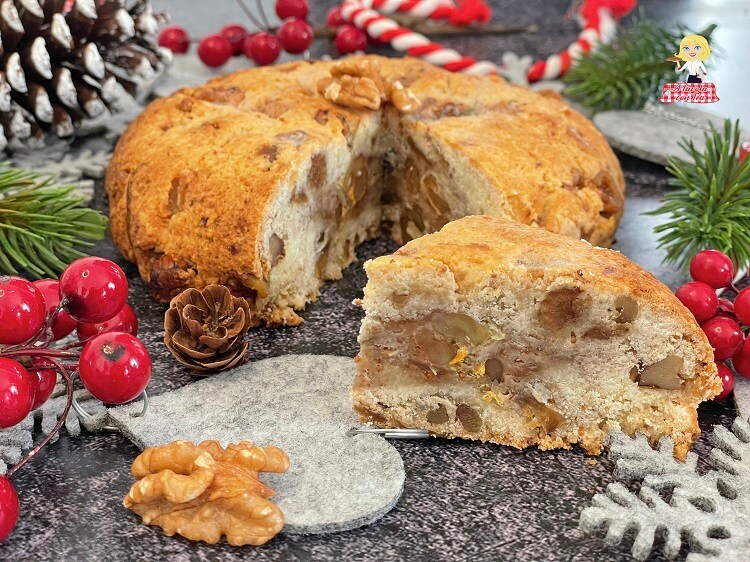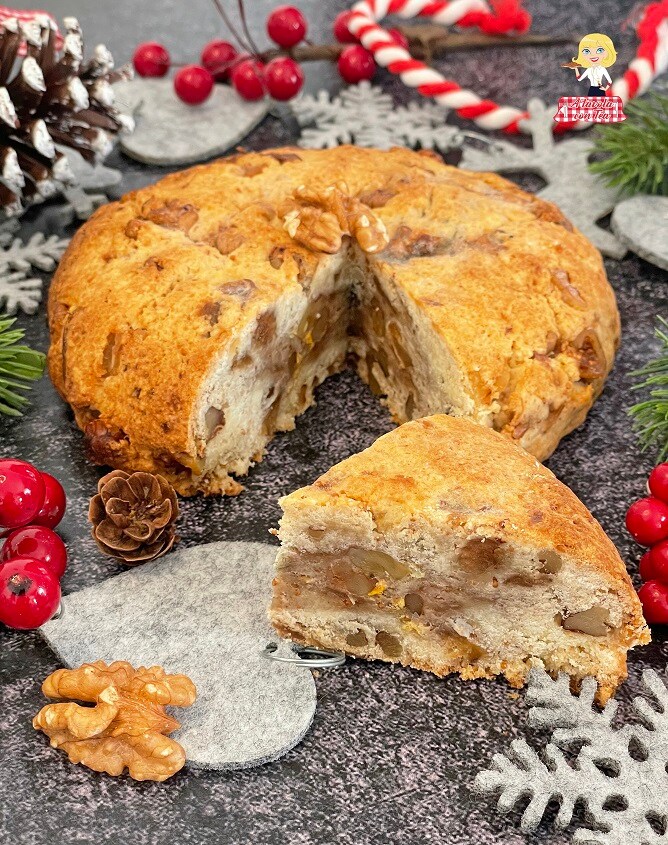GENOESE PANDOLCE with Figs and Walnuts
The GENOESE PANDOLCE is a traditional Christmas dessert from Genoa, widespread throughout Liguria. It has a circular shape, and there are two versions: the tall one, a leavened product made with sourdough or yeast, with a soft consistency, and the low one, a kind of shortcrust pastry enriched with raisins, candied fruits, and pine nuts.
Both versions are delicious, but the one my family has been making for generations is the Low Genoese Pandolce Recipe. I still have the little piece of paper that my grandmother would pull out of a kitchen drawer every year: crumpled, stained, with faded writing but absolutely perfect.
Luckily, my grandmother wasn’t one of those cooks who guarded their recipes and took their secrets to the grave. This legendary piece of paper reached me and allowed me to reach the finals in 2023—I came in 2nd place!—at the World Championship of Low Genoese Pandolce!
I must say that every year I look forward to Christmas just to smell that fantastic aroma wafting through the house when I bake it and enjoy a slice. Without ‘it,’ it wouldn’t be Christmas for me.
This year, I’ve decided to try a variation that, apart from the unchanged dough process and ingredients, uses dried figs and walnuts instead of candied fruit, both of which I adore.
I’ll just say that once it was ready, I had to hide it to enjoy a slice in peace… So if you want to deviate a little, but not too much, from tradition and try this version, turn on the oven, and let’s start.
For other variants of Pandolce, check the recipes below along with other Ligurian sweet specialties

- Difficulty: Very easy
- Cost: Medium
- Preparation time: 30 Minutes
- Portions: 2 pandolci of about 950 g
- Cooking methods: Oven
- Cuisine: Italian
- Seasonality: Christmas
- Energy 510.35 (Kcal)
- Carbohydrates 71.02 (g) of which sugars 24.30 (g)
- Proteins 9.71 (g)
- Fat 22.44 (g) of which saturated 8.83 (g)of which unsaturated 6.93 (g)
- Fibers 3.89 (g)
- Sodium 63.80 (mg)
Indicative values for a portion of 90 g processed in an automated way starting from the nutritional information available on the CREA* and FoodData Central** databases. It is not food and / or nutritional advice.
* CREATES Food and Nutrition Research Center: https://www.crea.gov.it/alimenti-e-nutrizione https://www.alimentinutrizione.it ** U.S. Department of Agriculture, Agricultural Research Service. FoodData Central, 2019. https://fdc.nal.usda.gov
Ingredients
- 4 3/4 cups Manitoba flour
- 2 1/3 cups all-purpose flour
- 4 eggs
- 1 1/3 cups butter
- 1/4 cup honey
- 1 1/2 cups granulated sugar
- 1 packet baking powder
- 1 tsp orange flower water (essence)
- salt (1 pinch)
- 2 1/3 cups sultana raisins
- 1 2/3 cups dried figs
- 1 2/3 cups walnut halves
- 1/2 cup pine nuts
Tools
- Bowl
- 2 Pans
Procedure
You can prepare the dough either by hand in a bowl and then transfer it to a work surface or in a stand mixer. It all depends on the quantities you use. I recommend using the stand mixer for a whole batch (two pandolci of about 2 lbs each) because, given the size, it’s not very easy to handle.
In a large bowl, sift together the two flours with the baking powder. Add the butter, at room temperature, cut into small pieces, and the sugar. Add the other ingredients as well: eggs, honey, orange flower essence, and a pinch of salt. Knead everything for at least 5/6 minutes (if kneading by hand, otherwise 3 minutes will suffice) to ensure all the ingredients blend well and the mixture is homogeneous.
Transfer the dough to a work surface, knead it slightly, and spread and flatten it with your hands. Place the dried fruit in the center: the previously plumped raisins, the dried figs cut into cubes as similar and small as possible, the walnuts, and finally the pine nuts. Knead, but not too much, to evenly incorporate all the dried fruit into the dough. I recommend adding it in two steps; it’s easier to knead.
At this point, you are ready to bake the fig and walnut Pandolce. Depending on the size you want to achieve, divide the dough. From this batch, I usually get two pandolci of about 2 lbs each. Once divided, shape each portion into a ball. Place it on a baking sheet covered with parchment paper and slightly flatten it with your hands, shaping the sides to give it the classic Pandolce shape. It should be about 1 1/2 inches high with a ‘hump’ in the center.
On each pandolce, make the typical cross cuts on the surface with a knife, not cutting too deep (a few millimeters is enough), not just for aesthetics but also for baking. Bake on the middle rack of a preheated static oven at 340°F for about 50 minutes. Baking times vary depending on the type of oven and the size of the pandolce. I recommend doing the toothpick test after about 45 minutes: if it comes out still wet, continue baking for a few more minutes. Remove from the oven and wait for it to cool completely before removing it from the pan.

Variations
Some recipes include the addition of fennel seeds and rum for an even more fragrant and aromatic product; others use anise seeds and marsala. You can also use grated lemon or orange zest for a citrus note. Recently in Genoa, versions have appeared with chocolate chips instead of candied fruits and toasted hazelnuts, for an even more indulgent variation suitable for the little ones.
History
The GENOESE PANDOLCE is a traditional end-of-meal dessert served in Genoa and the rest of Liguria during the Christmas period, so famous that even in English-speaking countries it is called Genoa Cake. The origins of the pandolce are ancient and date back to the 16th century. It is said that during the government of Andrea Doria, Doge of Genoa, it was prepared for the first time to showcase the cultural and gastronomic richness of the Ligurian maritime republic.
According to tradition, the GENOESE PANDOLCE was brought to the table at Christmas by the youngest family member, who handed it over to the oldest for cutting. Two slices of each Pandolce had to be saved: one was traditionally given to the poor, while the other was consumed on February 3rd, St. Blaise’s Day, for throat protection. In Genoa, you can find it all year round in two forms: tall pandolce and low pandolce.
Curiosities
It is believed to originate from ancient Persia and is a reworking of a large cake filled with candied fruits and apples: according to Persian custom, it was offered to the king on New Year’s Day, a tradition later adopted by the Ligurians themselves.
FAQ (Frequently Asked Questions)
How do you say pandolce in Genoese?
In Genoese, Pandolce is written as pandôçe and pronounced as panduse.

